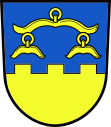Hrádek nad Olší
| Hrádek | ||||
|---|---|---|---|---|
|
||||
| Basic data | ||||
| State : |
|
|||
| Region : | Moravskoslezský kraj | |||
| District : | Frýdek-Místek | |||
| Area : | 979 ha | |||
| Geographic location : | 49 ° 37 ' N , 18 ° 45' E | |||
| Height: | 353 m nm | |||
| Residents : | 1,874 (Jan 1, 2019) | |||
| Postal code : | 739 97 | |||
| License plate : | T | |||
| traffic | ||||
| Street: | Český Těšín - Jablunkov | |||
| Railway connection: | Žilina – Bohumín | |||
| structure | ||||
| Status: | local community | |||
| Districts: | 1 | |||
| administration | ||||
| Mayor : | Robert Borski (as of 2009) | |||
| Address: | Hrádek 352 739 97 Hrádek nad Olší |
|||
| Municipality number: | 512176 | |||
| Website : | www.obechradek.cz | |||
Hrádek (Polish Gródek , German Grudek ) is a municipality in the Czech Republic . It is located eight kilometers southeast of Třinec and belongs to the Okres Frýdek-Místek .
geography
Hrádek is located on the right bank of the Olsa in the Jablunkauer furrow between the mountains of the Moravian-Silesian and Silesian Beskids . To the east rise along the border with Poland, the peaks of Velký Sošov (885 m), Ciešlar (921 m), Malý Stožec (843 m) and Velký Stožec (978 m). The mountains Skalka (649 m), Žďár (741 m) and Malý Kozinec (653 m) lie in the Beskydy Protected Landscape Area to the west. The European route 75 / state route 11 and the railway line Žilina – Bohumín lead through the village .
Neighboring towns are Bystřice in the north, Loučka, Jawornik and Wisła in the northeast, Pod Stožkem and Łabajów in the east, Návsí in the southeast, Bařiny, Harcov and Milíkov in the south, Košařiska in the southeast and Paseky in the east.
history
The place was probably built in the first half of the 12th century on the Kupfersteig, which led from Silesia over the Jablunka Pass to Hungary. To protect this trade connection and the country, a small castle complex was built on the banks of the Olsa around 1119, which was part of a system of guard castles against incursions from Hungary. The village of Jablunkov, first mentioned in a document in 1423, was built around the castle with its own church. When Hungarian troops invaded Silesia in 1447, the castle and the village of Jablunkov were razed to the ground.
Jablunkov was rebuilt in a new place and the settlement of Starý Jablunkov was established on the site of the devastated place during the reign of Duke Casimir II . In its first documentary mention, the place was referred to as Grodek in 1577 . It belonged to the Duchy of Teschen and after the death of the last Duchess of Teschen, Elisabeth Lucretia , fell together with him in 1653 as a settled fiefdom to the Crown of Bohemia , which had been ruled by the Habsburgs since 1526 . After the Kaiserstraße was built over the Jablunka Pass around 1780, the place grew. From 1843 crop failures, famine and epidemics led to the impoverishment of the place and a population loss of a tenth.
After the abolition of patrimonial , Grudek formed a community in the Teschen district from 1850 . Between 1869 and 1871 the kk privileged Kaschau-Oderberger Bahn also built a railway to Hungary. From 1880 several stone quarries were set up in the mountains east of the village and Italian master stonemasons settled in Grudek. At the 1891 census, the 108 houses of Grudek had 797 residents. 791 of them were Poles, six were of other nationalities, and there were no Czechs living in the village at the time. In 1895 a new Polish school was built. In 1901 there were 882 inhabitants, including 875 Poles and two Czechs.
After the collapse of the Austro-Hungarian monarchy in 1918, the border between Poland and Czechoslovakia was drawn on the Czantory ridge . Because of the large Polish population, Poland also claimed the Olsa area and the Polish-Czechoslovak border war broke out . From 1920 the place belonged to the Český Těšín district. After the Munich Agreement , Gródek was annexed to Poland in 1938 and joined the German Reich the following year after the occupation of Poland. Until 1945 Grudek belonged to the district of Teschen and came back to Czechoslovakia after the end of the war.
After the dissolution of the Okres Český Těšín, the place came to the Okres Frýdek-Místek at the beginning of 1961. In 1980 it was incorporated as a district Jablunkov 8-Hrádek after Jablunkov . Since 1990 Hrádek has again formed an independent municipality. A strong Polish minority lives in Hrádek, to which 43% of the population belonged in 2001.
Community structure
No districts are shown for the municipality of Hrádek. The settlements Dědina, Lyngi and Záplotí belong to Hrádek.
Attractions
- chapel
- Desert Burgstall
- 600-year-old winter linden , the 24 m high tree with a trunk circumference of 6.8 m stands in the north-western part of the village
Individual evidence
- ↑ Český statistický úřad - The population of the Czech municipalities as of January 1, 2019 (PDF; 7.4 MiB)

